1 EKARI (EKAGI) [Map] (cf S&C) Akaromani Apoejai ... - PapuaWeb
1 EKARI (EKAGI) [Map] (cf S&C) Akaromani Apoejai ... - PapuaWeb
1 EKARI (EKAGI) [Map] (cf S&C) Akaromani Apoejai ... - PapuaWeb
Create successful ePaper yourself
Turn your PDF publications into a flip-book with our unique Google optimized e-Paper software.
(<strong>EKAGI</strong>)<br />
[<strong>Map</strong>] (<strong>cf</strong> S&C)<br />
<strong>Akaromani</strong><br />
<strong>Apoejai</strong><br />
Bibiri<br />
Bomawo<br />
Botokeboe<br />
Deejèwéta<br />
Djina<br />
Doejawasiei<br />
Doraja'aratoe<br />
Dorisoewo<br />
Edaretali<br />
Enarotali<br />
Gepaoda<br />
Ibodyo<br />
Idakebo<br />
Imoejaiboeto<br />
Itodah<br />
Jamopa<br />
Jaroekebo<br />
Jotapoega<br />
Kerouda<br />
Kojogépa<br />
Korraratoe<br />
Mabalo<br />
Morodo<br />
Obaira<br />
Oegékebo<br />
Oenowobala<br />
Oeria<br />
Oewodimi<br />
Paraloewata<br />
Tigitoelapa<br />
Toeeida<br />
Toegimana<br />
- de Bruijn 1939a.<br />
[<strong>Map</strong>] (<strong>cf</strong> S&C)<br />
Ameraho<br />
Bidora<br />
Bomawo<br />
Bouloeda<br />
Doewodau<br />
Edawetapoera<br />
Idakebo<br />
Idemani<br />
Itodah<br />
Jamedoba<br />
<strong>EKARI</strong><br />
1
Jametari<br />
Jotapoega<br />
Kojogepa<br />
Marawapa<br />
Obai<br />
Oenowobalo<br />
Toegimana<br />
Weta<br />
- de Bruijn 1939b<br />
[de Bruyn 1939]<br />
... Het was immers reeds lang bekend, dat het woord Kapaoekoe van<br />
buiten geïmporteerd was. Het woord Kapaoea beteekent in de taal<br />
der Mimikanan: binnenland of achterland; Kapaoekoe zou dan<br />
beteekenen: "menschen van het achterland", ...<br />
In tegenstelling met andere bergstammen als de Magal, Wagal,<br />
Pesegems, etc., kent de bevolking in dit gedellete van het<br />
bergland de naam Kapaeokoe wel. ...<br />
- Tijdschrift "Nieuw-Guinea" 1939-40:193.<br />
... de bevolking meer van Kapaoekoes spreekt dan van Ekari's, het<br />
woord in hun eigen taal. ...<br />
- Tijdschrift "Nieuw-Guinea" 1939-40:194.<br />
Wat de taal der Ekari's en Moni's betreft, kan ik kort zijn.<br />
De eersten spreken wat tot nu toe het "Kapaoekoesch" is genoemd,<br />
dus thans beter het Ekarisch te noemen; de Moni's spreken wat tot<br />
nu toe het "Djonggoenoesch" genoemd is; dit blijkt dus ten rechte<br />
het Monisch te zijn.<br />
- Tijschrift "Nieuw-Guinea" 1939-40:197.<br />
... J.V. de Bruyn ... is of the opinion that the name of the<br />
Kapauku tribe should be changed, because Kapauku means<br />
"inlander". The real name of theses [sic] socalled Kapauku, is<br />
Ekari or Ekagi, while the real name of the Djonggunu is Moni. ...<br />
/ ... There is a third tribe, the Boani-people, with a somewhat<br />
doubtful psition. It may be that these Boanis belong to a Moniclan.<br />
The Izabu-valley is the frontier between Ekari- and Moniland.<br />
- Tijdschrift "Nieuw-Guinea" 1939-40:204-205.<br />
De zoogenaamde Kapaoekoes noemen zichzelve Ekari of Ekagi.<br />
De Monistammen, waarover straks, noemen hen Izani's, terwijl de<br />
zoogenaamde Kapaoekoes de Moni's als Mo betitelen. ... / ...<br />
Ekari of Ekagi is het "Kapaoekoe"-woord voor de z.g.<br />
Kapaoekoestam, Izani het "Djonggoenoe"-woord voor dezen stam;<br />
Moni is het "Djonggoenoe"-woord voor de z.g. Djonggoenoe-"stam",<br />
Mo het "Kapaoekoe"-woord voor dexen "stam". We plaatsen nu dus<br />
inplaats van de huidige minder juiste onderscheiding Kapaoekoe en<br />
Djonggoenoe tegenover elkander Ekari en Moni.<br />
2
- Tijdschrift "Nieuw-Guinea" 1939-40:194-195.<br />
Richting Koegapa -- naar het Noord-Oosten.<br />
Koegapa -- de Dzonggoenoe's [sic]; Kenea -- de Izani<br />
(Ekari's); Tetea -- de Izani; Izandora -- de Izani; Kemaboe -- de<br />
Izani + de Moni; Zenapa -- de Djonggoenoe's (ook de Migoegaa's<br />
wonen hier); Baynoelaloe -- de Djonggoenoe's; Doegendoeka -- de<br />
Djonggoenoe's (dit gebied is de Dogindora); Meakoe -- de<br />
Degoendoeni, de Moni's en de Danoekoe's; Igindoga -- de Wanoekeo<br />
[sic], de Dani's (Igindoga = Igiendora).<br />
...<br />
Richting Koegapa -- Zuid-Oost-Oost-Noord.<br />
Koegapa -- de Djonggoenoe's; Delema -- onbewoond; Wasima --<br />
de Djonggoenoe's, de Kobaja, de Izani's; Ondokapa -- de Kobajan,<br />
de Sinban (een clan van de Moni's); Jatasiega -- de Hanan<br />
(eveneens een clan van de Moni's). Met Jatasiega is Doemandora<br />
bereikt.<br />
Momasiega -- de Wandagan (= de Dendegao's); Jasiega -- de<br />
Oegoendoeni (Oehoendoeni); Wase -- idem; Poepasiega -- idem;<br />
Tegindoga -- idem; Illandoga -- idem; Normandoga -- idem; Eundoga<br />
-- idem; Meaka -- idem + de Danoekoe; Igiendoga -- de Waoekoe +<br />
de Dani's; Balimindoga -- idem; Todi -- idem.<br />
- de Bruyn 1940:262.<br />
*<br />
[<strong>Map</strong>]<br />
Enarotali<br />
Kotaboe<br />
Majareai<br />
Oewagimana<br />
Oewaligitoe<br />
Oeweboetoe<br />
Okawomanda<br />
Ore<br />
Totio<br />
Waibari<br />
Wanewaboe<br />
Waningdoka<br />
Woudapoer<br />
- Eyma 1940:427.<br />
*<br />
If we ask them [the Kamoro] whether the mountain folk are<br />
also kàmoro, they say, "No, they are mii," i.e. ghosts, or<br />
kapauku, "inland-dwellers." Are the Asmati, their neighbours to<br />
the east, the notorious cannibals, also kàmoro? Here they<br />
hesitate somewhat; in any case they are w_mana-wé, i.e. cannibalpeople.<br />
- Drabbe 1947-50:158.<br />
Ekari is een taal die gesproken wordt rondom de Paniai- en<br />
3
Tigi-meren (Wisselmeren), en verder in een zeer uitgestrekt<br />
gebied ten Oosten daarvan; een dialect ervan is Simari, dat we<br />
vinden ten Zuid-Westen der meren. Onze aantekeningen zijn<br />
verkregen van zegslui uit het dorp Jàba.<br />
- Drabbe 1949:423.<br />
*<br />
In the district of the lakes Paniai and Tigi (Wissel) and in<br />
a large region east of them a language is spoken called Ekarilanguage<br />
after the name Ekari which people give themselves. A<br />
dialect, called Simari after one of the tribes, is found southwest<br />
of the lakes. The informants of Drabbe were living in the<br />
village Jaba.<br />
- Boelaars 1950:103.<br />
*<br />
... Het Ekarisch wordt gesproken door de Jabi in het Weylandgebergte,<br />
de Simori in het Charles-Louis-gebergte en de<br />
eigenlijke Ekari in het merengebied en ten Zuiden van het Nassaugebergte<br />
tot in het bovenstroomgebied der Mimika. ...<br />
- le Roux 1950:805.<br />
*<br />
[Meyer Ranneft 1951-52]<br />
... Deze Ekaristam, waarvan ten minste 76 clans bekend zijn, heet<br />
een groot woongebied. Een belangrijk deel van de stam woont<br />
rondom de Wisselmeren, in de bovenloop van de Jaweh rivier, die<br />
de afvloeiïng is van het Paniai meer. Verder treft men hen aan<br />
in de bovenloop van de rivieren Kepare en /// Mimika ten oosten<br />
van de jaweh. Voorts zijn zij uitgezwermd naar het dal van de<br />
Kemaboe in het deel ten Westen van het punt waar de Izaboe in<br />
deze rivier vloeit.<br />
Hun woongebied strekt zich ten Westen van de Wisselmeren<br />
zeer ver uit en men treft hen aan in de Kamoevlakte (het dal van<br />
de Edere-rivier), in het dal van de Siriwo, de Boven-<strong>Map</strong>ía, in<br />
het Weyland gebergte, waar zij Jabi's worden genoemd en op de<br />
hellingen van het Charles Louis gebregte, waar zij de naam van<br />
Simori's dragen.<br />
De Tapiro's van de Boven-Mimika zijn de enige dwergen van de<br />
Ekaristam.<br />
- Tijdschrift "Nieuw-Guinea" 1952-1953:179, 182.<br />
[Editor's translation]<br />
Wissel Lake district is the native country of the Ekari<br />
tribe, though there are some settlements of Ekari's in the<br />
Kemabu-valley West of the Isabu junction.<br />
- Tijdschrift "Nieuw-Guinea" 1952-53:21.<br />
*<br />
... the Kapauku. This name, however, is no more than a trade<br />
4
term for them used by the Mimika natives, and is not used amongst<br />
the people themselves. The proper name is Ekari. ...<br />
- Capell 1954:4.<br />
... [Ekari] is spoken by some 10,000 people. ...<br />
- Capell 1954:5.<br />
*<br />
De Ekagi noemt zichzelf "mens" en onderscheidt als<br />
tegenstelling "andere mensen", anders in taal en zeden. Voor<br />
deze andere mensen heeft hij een aparte naam, zoals Mou (voor de<br />
Moni's), Wada Mou (voor de Wolani's), Ogito (voor de Uhunduni's),<br />
Kajaa (voor de Ndani's). Omgekeerd hebben de andere stammen een<br />
naam voor de Ekagi's, voor zover ze daarmee in nabij of ver<br />
contact staan en van hun bestaan afweten.<br />
- Boelen 1955:1.<br />
Zo beschouwen de bewoners van het Pania-meer zichzelf als<br />
centrum van het heelel en noemen de bewoners van het Tigi-meer<br />
"Tigi-bagee" (volk van Tigi), de bewoners van het Tage-meer<br />
"Tage-bagee" (volk van Tage), en de Kamubewoners "Kamu-bagee"<br />
(volk van de Kamu). Hoewel men niet aan de onderlinge<br />
verwantschap twijfelt, kan men geen overkoepelende naam<br />
produceren.<br />
- Boelen 1955:1.<br />
Men neemt de benamingen, die wij de mensen geven, gretig<br />
over. Zo is "Kapauku" een woord van de Zuidkust-Papoea's<br />
(Mimika-kust) en betekent "bergbewoner". Maar rondom de<br />
Wisselmeren wordt het thans druk door de Akagi's gebruikt om hun<br />
einen groep (stam) tegenover ons aan te duiden. Ook de Moni's in<br />
het Weja-dal (Kugapa) gebruiken het woord om tegenover ons de<br />
Ekagi's aan te duiden, waarvoor ze toch overigens wèl een eigen<br />
woord hebben, nl. "Izani".<br />
- Boelen 1955:1.<br />
De <strong>Map</strong>ija-bewoners (west van de Wisselmeren) noemen zichzelf<br />
"Timorini" of "Simorini", ter onderscheiding van de bewoners van<br />
de Kamu en de Wisselmeren, die zij "Ekagi" noemen en de bewoners<br />
Noord en West van de <strong>Map</strong>ija, die zij "Jabi" noemen. Deze<br />
verklaring is van Auki Tekege, het hoofd van Pogibado in het<br />
<strong>Map</strong>ija-bekken. Waarschijnlijk evenwel zijn hem bij het<br />
ondervragen, door verschillende bezoekers, problemen voorgelegd,<br />
waar hij nooit over gedacht heeft, maar waarover / hij zich toch<br />
verplicht voelt -- als zaken zijn eigen land aangaande -- een<br />
eigen mening te hebben. Later kregen deze woorden pas inhoud<br />
voor hem. Immers "Ekagi" is naar alle waarschijnlijkheid een<br />
Moni-woord en "Jabi" mogelijk een Ekagi-woord, doch het schijnt<br />
door de Noordkust-Papoea's gebruikt te worden in de betekenis van<br />
bergbewoners. Het is te verwachten dat de <strong>Map</strong>ija-bewoners<br />
zichzelve ook superieur achten boven de naburige groepen en<br />
5
zichzelve met "mens" voldoende aangeduid vinden.<br />
- Boelen 1955:1-2.<br />
In het Siriwo-gebied (= Bedu) wonen verspreid Ekagi's, die<br />
als grotere groep "Kupi's" genoemd worden. Noordelijk hieraan<br />
genzend en ook ten Westen daarvan wonen de "Auje's". Hoewel hun<br />
taal zeer verschilt van de Ekagi-taal, rekenen de bewoners van<br />
het Paniai-gebied hen tot de Ekagi's, terwijl ook de Moni's in<br />
het Weja-dal zeggen dat het "Ekagi's" zijn.<br />
Bij de Moni's kan het motief hierin liggen, dat de Auje's,<br />
waarmee ze niet trouwen mogen, als verder onbelangrijke groep,<br />
rustig tot de toch al wat minderwaardige Ekagi's gerekend mogen<br />
worden. En de Paniai-bewoners, die er wèl mee mogen trouwen,<br />
kunnen het doen om hun eigen groep een rijker aanzien te geven.<br />
Mogelijk hebben de Kupi's (bewoners van het Siriwo-gebied)<br />
en de Auje's zelf weer een andere mening en het is waarschijnlijk<br />
dat de Ekagi's van de Boven-Mimika-rivier (de Tapiro's) nooit van<br />
het bestaan der Auje's gehoord hebben.<br />
- Boelaars 1955:2.<br />
Het hart van het Ekagi-gebied is wel het gebied rond de drie<br />
/ Wisselmeren (Paniai, Tage en Tigi) en de Kamuvlakte (ten Westen<br />
van de Wisselmeren).<br />
Ten Noorden en ten Zuiden hiervan eindigen de nederzettingen<br />
der bevolkingsgroepen voor de moerassen van Noord- en Zuidkust.<br />
In het Oosten grenst het gebied der Ekagi's aan de Moni's in de<br />
Kemandoga (dal van de Kemabu) en in het Westen houden de<br />
nederzettingen der Bergbewoners geleidelijk aan ten Oosten van<br />
het Jamoer-meer op.<br />
- Boelen 1955:2-3.<br />
Bij verkenning van de grote rivieren van de Zuidkust bleek<br />
in het bovenstroomgebied van deze rivieren dat zich daar Ekagi's<br />
ophielden. De punten waar zij werden aangetroffen zijn op de<br />
kaart aangegeven.<br />
- Boelen 1955:3.<br />
In het bovenstroomgebied van de Kapare wonen de Tapiro's,<br />
die men tot de Ekagi's rekent, in de nederzetting 1 van de kaart,<br />
evenals in de bovenloop van de Korewap (zijrivier van de Kapare),<br />
nederzetting 2 van de kaart.<br />
En stroomopwaarts reizende langs de Oeta-rivier (verderop<br />
Oeroemoeka- en Jawei-rivier geheten) ontmoet men de Ekagi's noord<br />
van Orawja (kg. Temegetadi, tuma Anou) in nederzetting 3.<br />
- Boelen 1955:3.<br />
Aan de <strong>Map</strong>ija-rivier vindt men de eerste Ekaginederzettingen<br />
aan de Westelijke zijrivier de Kamo (kg. Egoubutu)<br />
in nederzetting 5.<br />
Aan de Awaroeka-rivier (Oostelijke tak van de Poronggo)<br />
bevinden zich Ekagi-nederzettingen in de uitlopes van het Charles<br />
Louis-gebergte bij punt 6, evenals aan de bovenloop van de Jera-<br />
6
ivier bij punt 7.<br />
In de bovenloop van de Omer-rivier bevindt zich een mengvolk<br />
van Kust- en Bergpapoea's ter hoogte van punt 8 en aan de<br />
bovenloop van de Omba, nl. in het stroomgebied van de Havahama-<br />
of Aroe-rivier, vindt men ter hoogte van de Oeriwo-rivier de<br />
eerste Ekagi-kampongs (kg. Atotagi) bij punt 9.<br />
In het Noordwesten van het Ekagi-gebied woont de groep, die<br />
men als Jabi kent. Hun nederzettingen bevinden zich aan de<br />
bovenloop van Wasai-, Menoo- en Soero-rivier (bronrivieren van de<br />
Wanggar) bij de punten 10.<br />
In het Noorden, in het Siriwo-gebied, vindt men de<br />
berbevolking pas bij de Adai-rivier, nl. de Auje's en verder<br />
stroomopwaarts tot de Jibe- of Sibei-rivier en mogelijk ook langs<br />
de Oetoewa-rivier. Hoewel de Auje-taal sterk afwijkt van de<br />
Ekagi-dialecten, rekenen de Paniai-bewoners hen tot de Ekagi-stam<br />
(11).<br />
In het Oosten eindigt het Ekagi-gebied vrijwel met de dalen<br />
van de rivieren die in het Paniai-meer uitmonden. Alleen langs<br />
de Egume-rivier (zijrivier van de Degewo of Kemabu) vindt men nog<br />
Ekagi's. Lands de Zuidoever van de Degewo of Kemabu, tussen de<br />
kgs. Uwagimoma en de Dawe- of Irabu-rivier, wonen ook Ekagi's.<br />
IN dit zelfde gebied bevinden zich enclaves van Moni's en<br />
Uhunduni's.<br />
- Boelen 1955:3-4.<br />
*<br />
(Ekari of Kapauku of Tapiro)<br />
boven-Umar, boven-Mimika, boven-Kamora, boven-Kapare, boven-<br />
Uta, ron de Wisselmeren, Ara-dal, Dumandora, Kumopa, Majepa,<br />
Ibowasiga, Itoda, Zalagunu, Kotabu, Keroto, Jaba, Wamberimi (+<br />
15.000 zielen).<br />
- Galis 1955-56:175.<br />
*<br />
Ekagi.<br />
Gesproken door de Kapaukoe (Jabi) bewoners van het Charles-<br />
Louis gebergte en Adai-Titinima gebied. In feite wordt het<br />
Simori-dialet gesproken, dat in details afwijkt van het Ekagi,<br />
zoals gesproken rond de Wisselmeren.<br />
- Peters 1956 Ts:53.<br />
*<br />
Aradide District, Paniai Onderafdeling:<br />
Ibouwosiga<br />
Ajabado<br />
Bopijatadi<br />
Dawaro<br />
Gebeutadi<br />
Dagagobado<br />
Ganijakato<br />
7
8<br />
Tipakobutu<br />
Jabamaida<br />
Karokadari<br />
Itokatadi<br />
Jeupe<br />
Jenutadi<br />
Akobaida<br />
Badaibado<br />
Akapija<br />
Potokawarari<br />
Komakero<br />
Maiba<br />
Jugago<br />
Kanebaida<br />
Ipouwo<br />
Tuka<br />
Uwopeuderita<br />
Bebiari<br />
Nawipauwo<br />
Pugaidari<br />
Namutadi<br />
Namudide<br />
Abatadi<br />
Bamoma<br />
Wetawodari<br />
Kobetakaida<br />
Ajajopa<br />
/<br />
Utidoke<br />
Watimato<br />
Bolatadi<br />
Obaipawaritaida<br />
Jarikotu<br />
Komopa<br />
Kogada<br />
Emai<br />
Tagija<br />
Dehaje<br />
Tuguwai<br />
Bumaida<br />
Koronepa<br />
Kenepugi<br />
Kopabaida<br />
Iteuwo<br />
Baguwo<br />
Obaimado<br />
Epotadi<br />
Jakawodide<br />
Bomaitakapa<br />
Tereije<br />
Jeritaida
Kagama<br />
Gege<br />
Ekawrijai<br />
Dogijato<br />
Pogeidimi<br />
Obaipugaida<br />
Jebagu<br />
Karokadari<br />
Tojaitadi<br />
Ijobado<br />
Dinibutu<br />
/<br />
Tojaimoti<br />
Wopabaida<br />
Bogobaida<br />
Odeida<br />
Wedari<br />
Kadaitadi<br />
Motito<br />
Munajepa<br />
Popouda<br />
Dorijato<br />
Emamu<br />
Agejepa<br />
Tigimuja<br />
- Zieck, Luitjes & Vink 1960 Ts:34-36.<br />
West-Paniai<br />
Pekegamo 294<br />
Ukauwo t.m.<br />
Kiito 719<br />
Okeitadi 689<br />
Aujatadi 1829<br />
Muje 909<br />
Uwebutu 821<br />
Dimija 178<br />
5439<br />
Oost-Paniai<br />
Zuid-Ekadide 1148<br />
Kebo 2755<br />
Jagai 1092<br />
Oost-Tage 665<br />
Jaweidide 605<br />
Pugodide 453<br />
Wejadide 3661<br />
Enarotali 1535<br />
11914<br />
- Zieck, Luitjes & Vink 1960 Ts:37.<br />
9
* * *<br />
[<strong>Map</strong>] (<strong>cf</strong> S&C)<br />
Abaimaida<br />
Badauwa<br />
Butokebo<br />
Dawaigunu<br />
Dei<br />
Enarotali<br />
Jerogota<br />
<strong>Map</strong>ia<br />
Obajeweta<br />
Obano<br />
Okaitidi<br />
Okomokepau<br />
Timepa<br />
Ugapuga<br />
- Couvée & Rijpstra 1961:284<br />
*<br />
[<strong>Map</strong>] (<strong>cf</strong> S&C)<br />
Enarotali<br />
Gakokebo<br />
Magode<br />
Obano<br />
- Hitt 1962.<br />
*<br />
The Ekagi language is spoken by a population of some 60.000<br />
in the area around the Wissel lakes in the central highlands of<br />
Western New Guinea. The designation 'Ekagi' has, as is now more<br />
usual, been adopted, in preference to the term 'Kapauku,' to<br />
denote both the language and the inhabitants of this region.<br />
- Steltenpool 1969:[iii].<br />
*<br />
Speakers of Ekagi number about 60,000 ... The Ekagi occupy<br />
valleys surrounding and to the north and west of the Paniai-Tigi<br />
lakes ...<br />
- Larson & Larson 1972:81.<br />
Ekagi is by far the largest language grouping of the EkWoMo<br />
family with from 60,000 to 100,000 speakers. ... The Ekagi occupy<br />
areas surrounding and out from the Wissel Lakes from as far<br />
southwest as <strong>Map</strong>iya to as far northeast as the lower Kemandoga.<br />
Here Ekagi speakers live in close proximity with both Wodani and<br />
Moni groups. ...<br />
- Larson 1977:5.<br />
*<br />
Ekagi (Kapauku) is spoken by over 60,000 people living in<br />
10
the valleys surrounding the Paniai and Tigi Lakes (Wissel Lakes)<br />
and on the headwaters of the Siriwo River to the north-west.<br />
There are numerous dialects in the language; of these, the Tigi<br />
dialect spoken round the government and mission station Enarotali<br />
is the best known. ...<br />
- Voorhoeve 1975b:406.<br />
+ 60.000 [speakers]<br />
Dialects: Paniai, Tigi, Kamu, <strong>Map</strong>ia, and several others.<br />
Villages: ?<br />
Comments: Earlier sources distinguish between three main<br />
groups among the Ekagi speaking people: Yabi in the north-west,<br />
Simori in the south-west, and Ekari in the east; it is not clear<br />
whether these divisions are congruent with major dialect<br />
divisions.<br />
- Voorhoeve 1975f:35.<br />
*<br />
[Table 11.1]<br />
<strong>EKAGI</strong> 55,000<br />
<strong>EKARI</strong> = <strong>EKAGI</strong><br />
KAPAUKU = <strong>EKAGI</strong><br />
ME = <strong>EKAGI</strong><br />
main centers: Eneratoli, Wissel Lakes<br />
- Hope & Hope 1976:227.<br />
*<br />
[<strong>Map</strong>]<br />
Uwapa -- <strong>EKAGI</strong><br />
Moanamani -- <strong>EKAGI</strong><br />
<strong>Map</strong>ia -- <strong>EKAGI</strong><br />
Waghete -- <strong>EKAGI</strong><br />
Obano -- <strong>EKAGI</strong><br />
Enarotali -- <strong>EKAGI</strong><br />
Paniai, Lake -- <strong>EKAGI</strong><br />
Tigi, Lake -- <strong>EKAGI</strong><br />
- Wurm & Hattori 1981<br />
*<br />
Ekari (Ekagi; Kapauku; Me Mana; Tapiro; Simori; Yabi;<br />
Auwje)<br />
POP: +/- 100,000<br />
LOC: Central New Guinea, West New Guinea Highlands, around<br />
Wissel Lakes<br />
...<br />
VILLAGE(S):<br />
stations<br />
Magodi<br />
Wanimani<br />
Wagete<br />
11
Tigi<br />
Enarotali<br />
Obano<br />
Kebo<br />
Kamopa<br />
Kegata<br />
- Silzer & Heikkinen 1984:84.<br />
(Ekagi; Kapauku; Me Mana; Tapiro; Simori; Yabi)<br />
100,000<br />
LOC: Central Highlands, around Wissel Lakes<br />
- Silzer & Clouse 1991:48.<br />
*<br />
... The Ekagi were estimated to number 60,000 in the 1960s (Doble<br />
1960; Pospisil 1958:13), but more recently in a 1977 census,<br />
about / 100,000. They occupy large areas in the region<br />
surrounding and to the north and west of the Wissel Lakes. With<br />
the Western Dani, they are the great traders of the interior<br />
Highlands who regularly traveled in precontact times to as far<br />
east as the edge of the Grand Valley. ...<br />
- Larson 1987:8-9.<br />
*<br />
"Ekari" is now the official name of the people formerly<br />
known as "Kapauku," and so named in some previously published<br />
works. The growing population of some 100,000 Ekari inhabit a<br />
territory in the west-central part of the highlands of the<br />
Indonesian province of Irian Jaya, located between 135 o 25' and<br />
137 o east longitude and 3 o 25' and 4 o 10' south latitude, in the<br />
Paniai Kabupaten (district). ...<br />
Larson and Larson (1972) describe the language family to<br />
which Ekari belongs as the "Ekari-Wodani-Moni language family."<br />
The dialect described is basically that of southeast Paniai,<br />
where the first government post was opened at Enarotali....<br />
- Doble 1987:55.<br />
*<br />
Ekari: 100,000 speakers reported in 1985, in the west<br />
central highlands, Irian Jaya. Also called Kapauku, Ekagi, Mee<br />
Mana, or Tapiro. ...<br />
- Comrie 1992ww:244.<br />
*<br />
West central highlands, Paniai, 135.25-137 E, 3.25-4.10 S.<br />
... Dialects: SIMORI, YABI (JABI), MAPIYA-KEGATA. Closest to<br />
Wolani. Slight dialect difference with <strong>Map</strong>iya-Kegata. ...<br />
- Grimes 1992:572.<br />
<strong>EKARI</strong> (KAPAUKU, <strong>EKAGI</strong>, MEE MANA, TAPIRO) ... 100,000 (1985<br />
Marion Doble CMA). West central highlands, Paniai, 135.25-137 E,<br />
12
3.25-4.10 S. ... Dialects: SIMORI, YABI (JABI), MAPIYA-KEGATA.<br />
Closest to Wolani. Slight dialect difference with <strong>Map</strong>iya-Kegata.<br />
They call themselves 'Me'. The Moni call them 'Ekari'.<br />
'Kapauku' is used for them by their southern neighbors. ...<br />
- Grimes 1996.<br />
<strong>EKARI</strong> (KAPAUKU, <strong>EKAGI</strong>, MEE MANA, TAPIRO) ... 100,000 (1985<br />
Marion Doble CMA). West central highlands, Paniai, 135.25-137 E,<br />
3.25-4.10 S. Linguistic affiliation: Trans-New Guinea, Main<br />
Section, Central and Western, Wissel Lakes-Kemandoga, Ekari-<br />
Wolani-Moni. Dialects: SIMORI, YABI (JABI), MAPIYA-KEGATA.<br />
Closest to Wolani. Slight dialect difference with <strong>Map</strong>iya-Kegata.<br />
... They call themselves 'Me'. The Moni call them 'Ekari'.<br />
'Kapauku' is used for them by their southern neighbors. ...<br />
- Grimes 2000.<br />
*<br />
... When we examine the various regions from east to west ..., we<br />
notice that there are [linguistic] differences between all of<br />
them, which, however, pale into insignifance when we compare the<br />
language spoken in all the other regions with that of the western<br />
<strong>Map</strong>ia area. ...<br />
- Hylkema 2002:240.<br />
The differences between the dialects of the other regions<br />
[Paniai and Kamu-Tigi] appear to be restricted to the vocabulary.<br />
...<br />
This is different as soon as one includes the <strong>Map</strong>ia language<br />
in the comparison. Firstly, the <strong>Map</strong>ia vocabulary includes a<br />
remarkable number of regionally specific words. ... the meanings<br />
of these words are not understood outside the region. ...<br />
Outsiders are irritated by the metatheses in frequently used<br />
words, ... The intelligibility of the language is especially<br />
affected by [t]he substitution of the 'j', as used elsewhere, by<br />
's' or 'h', which are unknown elsewhere. ...<br />
- Hylkema 2002:241.<br />
... each tribe has fixed names for neighbouring population<br />
groups. Sometimes they are names of individual tribes, but often<br />
of several different tribes. Generally the Ekagi referred to the<br />
Moni, their easterly neighbours, as 'Mou'. At a less general<br />
level, he distinuished the Mou from their neighbours, the Dani,<br />
or 'Kayaa'. ... The coastal peoples both to the north and to the<br />
south are indiscriminately referred to as ogai, ... they know<br />
that the Mou call them 'Isani', ...<br />
- Hylkema 2002:245.<br />
... The name Kapauku only appeared in the literature as late as<br />
the 1950's, to disappear again in the 1960's. Closely connected<br />
... with its foreign origin, the name had a pejorative ring for<br />
13
the Ekagi, even though the word itself has no derogatory<br />
connotation at all. It refers to the highlanders as tobacco<br />
suppliers to the coastal people. ...<br />
- Hylkema 2002:245.<br />
For a number of years the word mee has been promoted as a<br />
specific tribal name, especially by migrant Ekagi living in the<br />
varous coastal settlements. In this context they have narrowed<br />
down the meaning of the word for 'human'. ... / ...<br />
In the first place, the word mee is not an exclusively Ekagi<br />
word, but also forms part, wiuth the same meaning 'human being',<br />
of the vocabulary of the neighbouring Moni tribe. ... In the<br />
second place, mee denotes all highlanders collectively, as<br />
opposed to the coastal people collectively, or ogai. ... Although<br />
for all practical purposes the local population is meant by<br />
'humankind' in both cases, in principle the word denoted firstly<br />
all other Ekagi, and subsequently the neighbouring eastern<br />
tribes. ...<br />
- Hylkema 2002:245-246.<br />
... This word [Ekagi] is immediately recognizable in sound and<br />
form as having come into being as an authentic Ekagi word.<br />
Because it looks and sounds so authentic, it is all the more<br />
striking that its content hardly resonates [with] or appeals [to<br />
the people themselves]. It is a mysterious word. ... The name<br />
already crops up in the literature resulting from the first<br />
contacts [of the outside world] with the tribe. I should add,<br />
however, that in these documents it is used in conjunction with a<br />
second, related, but forgotten word Jimogi or Simogi. ... the<br />
early literature mentions two admittedly related, but<br />
nevertheless distinct, tribes. The name Simogi is reserved for<br />
the inhabitants of the region dominated by the Charle-Louis and<br />
Weyland ranges and the name Ekagi for the inhabitants of the<br />
regions dominated by the lakes. ...<br />
- Hylkema 2002:247.<br />
Simogi is the name of a remarkable mountain in the Weyland<br />
range. Similarly to what happened in the case of the name Moni<br />
[named after Mount Moni or Monibago], the name of this mountain<br />
has been used also with referenec to the people living around it.<br />
...<br />
- Hylkema 2002:250.<br />
[Ekagi <strong>cf</strong>. Mt. Eka]<br />
... the names Simogi and Eka designated the two extremities of<br />
the territorty in their polarity. Then, each of the two tribal<br />
halves was associated one of the two mountains. ...<br />
- Hylkema 2002:251.<br />
*<br />
[<strong>EKAGI</strong> ME]<br />
14
The dominant ethnic group in the Paniai area is also known<br />
by a number of names. Pospisil, who did research in a valley to<br />
the west of Paniai, used the name Kapauku. Dr Bruijn, one of the<br />
first administrative officers working in the area, and also<br />
Protestant and Catholic missionaries have used the term Ekari or<br />
Ekagi. Recently, Giay introduced the term Me, the vernacular<br />
word for 'people' (Giay 1995:xvii). Kapauku seems an<br />
inappropriate name since it is an exonym first used by south<br />
coast New Guineans to refer to the Highlanders to the north of<br />
them. As for Ekagi, missionaries such as Hylkema and van Nunen<br />
continue using this term, maintaining that it is not another //<br />
exonym first used by other Highlanders (pers. comm.). Moroever,<br />
although Giay is a Me himself and so seems to have the principal<br />
say, I wonder whether this is an appropriate name for a single<br />
ethnic group in a multi-ethnic political unit such as western New<br />
Guinea, in which other groups, specifically the Amung-me, also<br />
use the same term me to refer to 'people', As a tentative<br />
alternative I have used the term Ekagi-me instead (Ploeg 1996).<br />
Ekagi-me live in the western tip of the Central Highlands, and<br />
the Paniai lakes are at the eastern end of their territories. ...<br />
- Ploeg 2000:401, 403.<br />
*<br />
[ALUA]<br />
Ten Westen van basiskamp, door de bergrug van de beide daar<br />
wonende Bergpapoastammen gescheiden, aan de noordvoet van de<br />
Godman, woont de Aloeastam -- Aloeadal -- die in tegenstelling<br />
met de Balalstam waarschijnlijk niet verwant is aan de<br />
Enggipiloedal. Niet alleen wordt hier een stamverwantschap met<br />
even grote heftigheid ontkend, doch ook de taal van deze Aloea's<br />
/ verschilt geheel van die der Enggipiloe-papoea's.<br />
- Colijn n.d.[1937:182-183.<br />
*<br />
[JABI]<br />
Van den bovenloop Siriwo tot aan den bovenloop van de Wamma<br />
worden vele noordelijke uitloopers van het Weylandgebergte<br />
bewoond door Jabi's; zij zijn echter verdeeld in twee stammen.<br />
Volgens de Jabi's van de boven Wanggar zouden zij een andere taal<br />
spreken dan die van de Boven Siriwo.<br />
- Kuik 1937-38:143.<br />
*<br />
(KAPAUKU)<br />
Deze Bergpapoea's kennen de naam Kapauko, waarmee wij ze in<br />
de voorgaande hoofdstukken steeds hebben aangeduid, zelf niet.<br />
De naam is namelijk afgeleid van het woord Kapaua, dat in de taal<br />
der Kustpapoea's binnenland of achterland betekent. Kapauko's<br />
wil dus zeggen, bewoners van het binnenland.<br />
- Colinj n.d.[1937]:182.<br />
*<br />
15
The Kepaoekoe or Ekari are estimated to have a population of<br />
some 30,000 people, living mostly in the vicinity of the Wissel<br />
Lakes. ...<br />
- Post 1943:80.<br />
*<br />
Kapaukoe. -- The Kapaukoes inhabit the area from Lake Paniai<br />
east to the Magataga Pass. This is generally recognized as<br />
Kapaukoe territory even though a large portion of the area is not<br />
inhabited. The area from the Araboe River northeast is thus<br />
jungle and uninhabited. ...<br />
- Christian and Missionary Alliance 1955:323.<br />
*<br />
Kapauku is a name applied by the coastal people of<br />
southwestern Netherlands New Guinea to a tribe of about 60,000<br />
Mountain Papuans who inhabit an area in the Central Highlands<br />
located between 135 o 25' and 137 o east longitude and 3 o 25' and<br />
4 o 10' south latitude ... The Moni Papuans who live to the<br />
northeast of this area named them Ekari. The people call<br />
themselves "Me" which means "the people."<br />
- Pospisil 1958:13.<br />
The five villages ... are situated in a curved line<br />
extending from southwest to northeast in the following fashion:<br />
Aigii, Jagawaugii, Botukebo, Itoda-Kojogeepa and Obajbegaa. ...<br />
To this union of five villages also belongs Notiito, ... / ...<br />
and Bumauwobado, ...<br />
- Pospisil 1958:66-67.<br />
... The five main villages of the [Ijaaj-Pigome] confederacy are<br />
situated in a curved line which extends from southwest to<br />
northeast in the following sequence: Aigii, Jagawaugii, /<br />
Botukebo, Kojogeepa, and Obajbegaa. ... Two additional villages<br />
which belong to the confederacy are situated nearby. Notiito ...<br />
Bunauwobado, ...<br />
- Pospisil 1963a:53-54.<br />
Table 1. List of Residents of Botukebo [village of origin]<br />
[Botukebo<br />
Booboobutu<br />
<strong>Map</strong>ia<br />
Kegoukago<br />
Bukwaagotu<br />
Obajbega<br />
Badouda<br />
Jotapuga<br />
Deemaago<br />
Bibigi<br />
Mooma<br />
Kebodagi<br />
16
Kojogeepa<br />
Degeipige<br />
Egebutu<br />
Badouda<br />
Pagoja<br />
Obaaj<br />
Tuguteke<br />
Mogodagi<br />
Pona<br />
Ginopigi<br />
- Pospisil 1963a:411-415.<br />
[<strong>Map</strong>]<br />
Aigii -- KAPAUKU<br />
Botukebo -- KAPAUKU<br />
Bunauwobado -- KAPAUKU<br />
Enarotali -- KAPAUKU<br />
Jagawaugii -- KAPAUKU<br />
Notiito -- KAPAUKU<br />
Obajbegaa -- KAPAUKU<br />
Udateida -- KAPAUKU<br />
Waghete -- KAPAUKU<br />
- Pospisil 1963:18.<br />
*<br />
The Kapauku dialects of this dictionary are spoken by<br />
approximately 35,000 people calling themselves Me, and their<br />
language Ma Mana, in the Wisselmeren area in the extreme western<br />
section of the Nassau Mountains of Netherlands New Guinea. ...<br />
...<br />
Dialect differences between Lakes Paniai and Tigi are<br />
indicated where known with (P) or (T) following. An infrequent<br />
(E) indicates the dialect east of Enarotali. ...<br />
- Doble 1960:1.<br />
*<br />
MEE<br />
The people of Misty Ridge use the name Mee to designate<br />
their own ethnic group.[17] The word mee literally means people<br />
or human when used in their language Mee Mana ('human words').<br />
...<br />
- Kirksey 2000:[56].<br />
... In the Siriwo River Valley there are villages of Auye<br />
people and villages of [Ekari] Mee. Both groups view themselves<br />
as distinct from the other. ...<br />
- Kirksey 2000:[59].<br />
In the context of this thesis the name Oge Bage Mee refers<br />
specifically to a collection of people living in some 20 villages<br />
sparsely scattered in the Siriwo River Valley, which is more than<br />
17
100 km long. The name Oge Bage Mee distinguishes the people that<br />
I studied from the Mee who live in the highlands, and it<br />
separates them from the Auye, since in the Auye language oge<br />
means foreign (Mike Moxness, personal communication 1999). In<br />
the highland dialects of the Mee language, oge means hidden or<br />
obscured. Until the 1970s there was little contact between<br />
highland Mee and the Oge Bage Mee (Leopold Pospisil, personal<br />
communication 1999). The word oge generally refers to the<br />
lowlands in the Mee dialect spoken in Misty Ridge. ...<br />
- Kirksey 2000:[60].<br />
* * *<br />
[NAGAI]<br />
De stam der Nagai aan de bovenloop der Kamora moet wel<br />
verwant zijn met de Aloeadal, maar natuurlijk kan in al deze<br />
gevallen slechts een diepgaand wetenschappelijk onderzoek de<br />
oplossing brengen van de verschillende vraagstukken, die zich in<br />
verband met deze verwantschapsmogelijkheiden voordoen.<br />
- Colijn n.d.[1937]:183.<br />
*<br />
(SIMORI)<br />
op en om het Charles Louis-gebergte (+ 5000 zielen).<br />
- Galis 1955-56:175.<br />
* * *<br />
18
<strong>EKAGI</strong> (own name) Tijdschrift "Nieuw-Guinea" 1939-40<br />
(de Bruyn)<br />
<strong>EKAGI</strong> 10,000 Capell 1954<br />
<strong>EKAGI</strong> Boelen 1955; Peters 1956 Ts; Galis<br />
1960; Salzner 1960; Capell 1962,<br />
1969; Hylkema 2002<br />
<strong>EKAGI</strong> 60,000 Steltenpool 1969,<br />
<strong>EKAGI</strong> = KAPAUKU Wurm 1971<br />
<strong>EKAGI</strong> 55,000 Hope & Hope 1976<br />
<strong>EKAGI</strong> Wissel Lakes-Kenadoga (Larson 1977)<br />
<strong>EKAGI</strong> Ekagi Family (Gajdusek et al 1978)<br />
<strong>EKAGI</strong> 65,000 Ekagi-Wodani-Moni (Wurm &<br />
Hattori 1981, Wurm 1982)<br />
<strong>EKAGI</strong> 60,000 Wissel Lakes (Foley 1986)<br />
<strong>EKAGI</strong> 100,000 Ekagi-Wodani-Moni (Larson<br />
1987, Wurm 1994)<br />
<strong>EKAGI</strong> = <strong>EKARI</strong> Silzer & Heikkinen 1984; Silzer &<br />
<strong>EKAGI</strong> = <strong>EKAGI</strong> ME Ploeg 2000<br />
<strong>EKARI</strong> (own name) Tijdschrift "Nieuw-Guinea" 1939-40<br />
(de Bruyn)<br />
<strong>EKARI</strong> de Bruyn 1940<br />
<strong>EKARI</strong> = KAPAOEKOE Post 1943<br />
<strong>EKARI</strong> Drabbe 1949, le Roux 1950, Capell<br />
<strong>EKARI</strong> (own name) Boelaars 1950<br />
<strong>EKARI</strong> Tijdschrift "Nieuw-Guinea" 1952-53<br />
(Meyer Ranneft)<br />
<strong>EKARI</strong> 15,000 Galis 1955-56<br />
<strong>EKARI</strong> = KAPAUKU (MONI name) Pospisil 1958<br />
<strong>EKARI</strong> = <strong>EKAGI</strong> Salzner 1960; Capell 1962; Hope &<br />
<strong>EKARI</strong> = KAPAUKU Wurm 1971fl<br />
<strong>EKARI</strong> -- <strong>EKAGI</strong> Voorhoeve 1975<br />
<strong>EKARI</strong> 100,000 Ekagi-Wodani-Moni (Silzer<br />
& Heikkinen 1984, Silzer<br />
& Clouse 1991, Grimes<br />
<strong>EKARI</strong> 100,000 Doble 1987<br />
<strong>EKARI</strong> 100,000 (1985) Comrie 1992ww<br />
<strong>EKARI</strong> (MONI name) 100,000 Ekari-Wolani-Moni (Grimes<br />
1996, 2000)<br />
<strong>EKARI</strong> = MEE Kirksey 2000<br />
<strong>EKARI</strong> = <strong>EKAGI</strong> ME Ploeg 2000<br />
<strong>EKAGI</strong> ME Ploeg 2000<br />
AUJE -- <strong>EKAGI</strong> Boelen 1995<br />
AUWJE = <strong>EKARI</strong> Silzer & Heikkinen 1984<br />
IMANG = <strong>EKAGI</strong> Salzner 1960<br />
IZANI = KAPAOEKOE (DJONGGOENOE<br />
name) Tijdschrift "Nieuw-Guinea" 1939-40<br />
19
(de Bruyn)<br />
IZANI -- <strong>EKARI</strong> de Bruyn 1940<br />
IZANI = <strong>EKAGI</strong> (MONI name) Boelen 1955<br />
IZANI = <strong>EKAGI</strong> Salzner 1960<br />
JABI Kuik 1937-38<br />
JABI -- <strong>EKARI</strong> le Roux 1950, Tijdschrift "Nieuw-<br />
JABI -- <strong>EKAGI</strong> (<strong>Map</strong>ia name) Boelen 1955 (<strong>cf</strong> S&C)<br />
JABI = KAPAUKOE -- <strong>EKAGI</strong> Peters 1956 Ts<br />
JABI -- d of <strong>EKAGI</strong> Salzner 1960, Capell 1962<br />
JABI = YABI d of <strong>EKARI</strong> Wurm 1971fl; Grimes 1992, 1996,<br />
YABI Capell 1954<br />
YABI -- d of <strong>EKAGI</strong> Capell 1962, Wurm 1982<br />
YABI -- d of <strong>EKARI</strong> Grimes 1992, 1996, 2000<br />
YABI -- d of KAPAUKU Wurm 1971fl<br />
YABI = <strong>EKARI</strong> Silzer & Heikkinen 1984<br />
KAMU-BAGEE = <strong>EKAGI</strong> Boelen 1955<br />
KAMU -- d of <strong>EKAGI</strong> Voorhoeve 1975<br />
KAPAOEKOE = <strong>EKARI</strong> (MIMIKA<br />
name) Tijdschrift "Nieuw-Guinea" 1939-40<br />
(de Bruyn]<br />
KEPAOEKOE 30,000 Post 1943<br />
KAPAUKO (coastal name) Colijn n.d.[1937]<br />
KAPAUKU = <strong>EKAGI</strong>, <strong>EKARI</strong><br />
(Kamoro name) Drabbe 1947-50<br />
KAPAUKU = <strong>EKAGI</strong> (MIMIKA<br />
name) Boelen 1955<br />
KAPAUKU = <strong>EKARI</strong> Galis 1955-56; Silzer & Heikkinen<br />
KAPAUKOE -- <strong>EKAGI</strong> Peters 1956 Ts<br />
KAPAUKU 60,000 Pospisil 1958, 1963<br />
KAPAUKU = <strong>EKAGI</strong> Salzner 1960; Capell 1962;<br />
Steltenpool 1969; Voorhoeve 1975;<br />
Hope & Hope 1976; Larson 1977; Wurm<br />
& Hattori 1981; Wurm 1982, 1994;<br />
Foley 1986<br />
KAPAUKU 10,000 Wurm 1971<br />
KAPAUKU = <strong>EKARI</strong> (Southern<br />
neighbors' name) Grimes 1996<br />
KAPAUKU = <strong>EKAGI</strong> ME Ploeg 2000<br />
KAPAUKU = <strong>EKAGI</strong> (foreign<br />
name) Hylkema 2002<br />
KUPI = <strong>EKAGI</strong> (Siriwo <strong>EKAGI</strong><br />
name) Boelen 1955<br />
MAPIA Galis 1960, Capell 1962 (Galis)<br />
MAPIA -- d of <strong>EKAGI</strong> Voorhoeve 1975, Wurm & Hattori<br />
MAPIJA -- <strong>EKAGI</strong> Boelen 1955 (<strong>cf</strong> S&C)<br />
20
MAPIYA-KEGATA -- d of <strong>EKARI</strong> Grimes 1992, 1996, 2000<br />
ME = KAPAUKU (own name) Pospisil 1958, Doble 1960<br />
ME = <strong>EKAGI</strong> Hope & Hope 1976<br />
ME = <strong>EKARI</strong> (own name) Grimes 1996, 2000<br />
ME = <strong>EKAGI</strong> ME Ploeg 2000<br />
MEE (own name) Kirksey 2000<br />
MEE = all highlanders Hylkema 2002<br />
MA-MANA = KAPAUKU (own name<br />
for language) Doble 1960<br />
ME MANA = <strong>EKARI</strong> Silzer & Heikkinen 1984, Silzer &<br />
MEE MANA = <strong>EKARI</strong> Comrie 1992ww; Grimes 1992, 1996,<br />
MII = KAPAUKU (Kamoro name) Drabbe 1947-50<br />
PANIA -- sd of <strong>EKAGI</strong> -- d of<br />
<strong>EKAGI</strong> Salzner 1960<br />
PANIAI -- d of <strong>EKAGI</strong> Voorhoeve 1975, Larson 1977, Wurm &<br />
Hattori 1981, Wurm 1982<br />
PANIAI -- d of <strong>EKARI</strong> Doble 1989<br />
PANIAI -- d of KAPAUKU Doble 1960<br />
JIMOGI -- <strong>EKAGI</strong> Hylkema 2002<br />
SIMOGI = JIMOGI -- <strong>EKAGI</strong> Hylkema 2002<br />
SIMORI -- <strong>EKARI</strong> le Roux 1950, Tijdschrift "Nieuw-<br />
SIMORI 5,000 Galis 1955-56<br />
SIMORI -- <strong>EKAGI</strong> Galis 1960<br />
SIMORI = <strong>EKAGI</strong> Voorhoeve 1975<br />
SIMORI = <strong>EKARI</strong> Silzer & Heikkinen 1984, Silzer &<br />
SIMORINI = TIMORINI -- <strong>Map</strong>ia<br />
<strong>EKAGI</strong> (own name) Boelen 1955<br />
SIMARI -- d of <strong>EKARI</strong> Drabbe 1949, Boelaars 1950<br />
SIMORI -- d of <strong>EKAGI</strong> Peters 1956 Ts, Salzner 1960, Capell 196<br />
SIMORI -- d of KAPAUKU Wurm 1971fl<br />
SIMORI -- d of <strong>EKARI</strong> Grimes 1996, 2000<br />
TAGE-BAGEE = <strong>EKAGI</strong> Boelen 1955<br />
TAPIRO -- <strong>EKARI</strong> Tijdschrift "Nieuw-Guinea" 1952-53<br />
(Meyer Ranneft)<br />
TAPIRO Capell 1954, 1962<br />
TAPIRO -- <strong>EKAGI</strong> Boelen 1955<br />
TAPIRO = ? GOLIATH Wurm 1971fl<br />
TAPIRO = <strong>EKAGI</strong> Wurm & Hattori 1981<br />
TAPIRO = <strong>EKARI</strong> Galis 1955-56; Silzer & Heikkinen<br />
TAPIRO = ? GOLIATH<br />
TIGI-BAGEE = <strong>EKAGI</strong><br />
TIGI -- d of KAPAUKU<br />
TIGI -- d of <strong>EKAGI</strong><br />
21
TIMORI = SIMORI d of <strong>EKAGI</strong> Salzner 1960<br />
TIMORINI = <strong>Map</strong>ia <strong>EKAGI</strong> (own<br />
name)<br />
UNGUNA = YABI<br />
Abaimaida -- <strong>EKAGI</strong> Couvée & Rijpstra 1961<br />
Abatadi -- Paniai<br />
Agejepa -- Paniai<br />
Aigii -- KAPAUKU 1958, Pospisil 1963<br />
Ajabado -- Paniai Zieck, Luitjes & Vink 1960 Ts<br />
Ajajopa -- Paniai Zieck, Luitjes & Vink 1960 Ts<br />
Akapija -- Paniai Zieck, Luitjes & Vink 1960 Ts<br />
<strong>Akaromani</strong> -- <strong>EKAGI</strong> de Bruijn 1939a (<strong>cf</strong> S&C)<br />
Akobaida -- Paniai Zieck, Luitjes & Vink 1960 Ts<br />
ALOEA Colijn n.d.[1937]<br />
ALUA -- sd of <strong>EKAGI</strong> -- d of<br />
<strong>EKAGI</strong> Salzner 1960<br />
Ameraho -- <strong>EKAGI</strong> de Bruijn 1939b (<strong>cf</strong> S&C)<br />
<strong>Apoejai</strong> -- <strong>EKAGI</strong> de Bruijn 1939a (<strong>cf</strong> S&C)<br />
Ara Valley -- <strong>EKARI</strong> Galis 1955-56<br />
Ariya -- <strong>EKARI</strong> Boelaars 1995 [Tillemans] (<strong>cf</strong> S&C)<br />
Atotagi -- <strong>EKAGI</strong> Boelen 1955<br />
Atotoki -- <strong>EKARI</strong> Boelaars 1995 [Tillemans] (<strong>cf</strong> &C)<br />
Aujatadi -- West Paniai Zieck, Luitjes & Vink 1960 Ts<br />
Awaroeka R -- <strong>EKAGI</strong> Boelen 1955<br />
Badaibado -- Paniai Zieck, Luitjes & Vink 1960 Ts<br />
Badouda -- KAPAUKU Pospisil 1963<br />
Badauwa -- <strong>EKAGI</strong> Couvée & Rijpstra 1961 (<strong>cf</strong> S&C)<br />
22
Baguwo -- Paniai Zieck, Luitjes & Vink 1960 Ts<br />
Bamoma -- Paniai Zieck, Luitjes & Vink 1960 Ts<br />
Bebiari -- Paniai Zieck, Luitjes & Vink 1960 Ts<br />
Bedu = Siriwo <strong>EKAGI</strong> Boelen 1955<br />
Bibigi -- KAPAUKU Pospisil 1963<br />
Bibiri -- <strong>EKAGI</strong> de Bruijn 1939a (<strong>cf</strong> S&C)<br />
Bidora -- <strong>EKAGI</strong> de Bruijn 1939b (<strong>cf</strong> S&C)<br />
Bogobaida -- Paniai Zieck, Luitjes & Vink 1960 Ts<br />
Bolatadi -- Paniai Zieck, Luitjes & Vink 1960 Ts<br />
Bomaitakapa -- Paniai Zieck, Luitjes & Vink 1960 Ts<br />
Bomawo -- <strong>EKAGI</strong> de Bruijn 1939a, 1939b (<strong>cf</strong> S&C)<br />
Booboobutu -- KAPAUKU Pospisil 1963<br />
Bopijatadi -- Paniai Zieck, Luitjes & Vink 1960 Ts<br />
Botokeboe -- <strong>EKAGI</strong> de Bruijn 1939a (<strong>cf</strong> S&C)<br />
Botukebo -- KAPAUKU Pospisil 1958, 1963<br />
Butokebo -- <strong>EKAGI</strong> Couvée & Rijpstra 1961 (<strong>cf</strong> S&C)<br />
Bouloeda -- <strong>EKAGI</strong> de Bruijn 1939b (<strong>cf</strong> S&C)<br />
Bukwaagotu -- KAPAUKU Pospisil 1963<br />
Bumaida -- Paniai Zieck, Luitjes & Vink 1960 Ts<br />
Bumauwobado -- KAPAUKU Pospisil 1958<br />
Bunauwobado -- KAPAUKU Pospisil 1963<br />
Charles Louis Mts -- <strong>EKAGI</strong> Boelen 1955<br />
Dagagobado -- Paniai Zieck, Luitjes & Vink 1960 Ts<br />
Dawaigunu -- <strong>EKAGI</strong> Couvée & Rijsptra 1961 (<strong>cf</strong> S&C)<br />
Dawaro -- Paniai Zieck, Luitjes & Vink 1960 Ts<br />
Deejèwéta -- <strong>EKAGI</strong> de Bruijn 1939a (<strong>cf</strong> S&C)<br />
Diyay -- <strong>EKARI</strong> Boelaars 1995 [Tillemans] (<strong>cf</strong> S&C)<br />
Deemaago -- KAPAUKU Pospisil 1963<br />
23
Degeipige -- KAPAUKU Pospisil 1963<br />
Dehaje -- Paniai Zieck, Luitjes & Vink 1960 Ts<br />
Dei -- <strong>EKAGI</strong> Couvée & Rijpstra 1961 (<strong>cf</strong> S&C)<br />
Dimija -- West Paniai Zieck, Luitjes & Vink 1960 Ts<br />
Dinibutu -- Paniai Zieck, Luitjes & Vink 1960 Ts<br />
Djina -- <strong>EKAGI</strong> de Bruijn 1939a (<strong>cf</strong> S&C)<br />
Dogijato -- Paniai Zieck, Luitjes & Vink 1960 Ts<br />
Doraja'aratoe -- <strong>EKAGI</strong> de Bruijn 1939a (<strong>cf</strong> S&C)<br />
Dorijato -- Paniai Zieck, Luitjes & Vink 1960 Ts<br />
Dorisoewo -- <strong>EKAGI</strong> de Bruijn 1939a (<strong>cf</strong> S&C)<br />
Doejawasiei -- <strong>EKAGI</strong> de Bruijn 1939a (<strong>cf</strong> S&C)<br />
Dumandora -- <strong>EKARI</strong> Galis 1955-56<br />
Doewodau -- <strong>EKAGI</strong> de Bruijn 1939b (<strong>cf</strong> S&C)<br />
Edaretali -- <strong>EKAGI</strong> de Bruijn 1939a (<strong>cf</strong> S&C)<br />
Edawetapoera -- <strong>EKAGI</strong> de Bruijn 1939b (<strong>cf</strong> S&C)<br />
Egebutu -- KAPAUKU Pospisil 1963<br />
Egoubutu -- <strong>EKAGI</strong> Boelen 1955<br />
Egume Valley -- <strong>EKAGI</strong> Boelen 1955<br />
Ekadide, Zuid -- East Paniai Zieck, Luitjes & Vink 1960 Ts<br />
<strong>EKAGI</strong> -- d of <strong>EKAGI</strong> Salzner 1960<br />
Ekawrijai -- Paniai Zieck, Luitjes & Vink 1960 Ts<br />
Emai -- Paniai Zieck, Luitjes & Vink 1960 Ts<br />
Emamu -- Paniai Zieck, Luitjes & Vink 1960 Ts<br />
ENAROTALI -- sd of <strong>EKAGI</strong> --<br />
d of <strong>EKAGI</strong> Salzner 1960<br />
Enarotali -- East Paniai Zieck, Luitjes & Vink 1960 Ts<br />
Enarotali -- KAPAUKU Doble 1960, Pospisil 1963<br />
Enarotali -- <strong>EKAGI</strong> de Bruijn 1939a (<strong>cf</strong> S&C); Eyma 1940<br />
24
(<strong>cf</strong> S&C); Couvée & Rijpstra 1961<br />
Enarotali -- <strong>EKARI</strong> Doble 1989, Silzer & Heikkinen<br />
Eneratoli -- <strong>EKAGI</strong> Hope & Hope 1976<br />
Epotadi -- Paniai Zieck, Luitjes & Vink 1960 Ts<br />
Epouto -- <strong>EKARI</strong> Silzer & Clouse 1991<br />
Gakokebo -- <strong>EKAGI</strong> Hitt 1962 (<strong>cf</strong> S&C)<br />
Ganijakato -- Paniai Zieck, Luitjes & Vink 1960 Ts<br />
Gebeutadi -- Paniai Zieck, Luitjes & Vink 1960 Ts<br />
Gege -- Paniai Zieck, Luitjes & Vink 1960 Ts<br />
Gepaoda -- <strong>EKAGI</strong> de Bruijn 1939a (<strong>cf</strong> S&C)<br />
Ginopigi -- KAPAUKU Pospisil 1963<br />
Ibodyo -- <strong>EKAGI</strong> de Bruijn 1939a (<strong>cf</strong> S&C)<br />
Ibouwosiga -- Paniai Zieck, Luitjes & Vink 1960 Ts<br />
Ibowasiga -- <strong>EKARI</strong> Galis 1955-56<br />
Idakebo -- <strong>EKAGI</strong> de Bruijn 1939a, 1939b (<strong>cf</strong> S&C)<br />
Idemani -- <strong>EKAGI</strong> de Bruijn 1939b (<strong>cf</strong> S&C)<br />
Ijobado -- Paniai Zieck, Luitjes & Vink 1960 Ts<br />
Imoejaiboeto -- <strong>EKAGI</strong> de Bruijn 1939a (<strong>cf</strong> S&C)<br />
Ipouwo -- Paniai Zieck, Luitjes & Vink 1960 Ts<br />
Iteuwo -- Paniai Zieck, Luitjes & Vink 1960 Ts<br />
Itoda -- <strong>EKARI</strong> Galis 1955-56<br />
Itodah -- <strong>EKAGI</strong> de Bruijn 1939a, 1939b (<strong>cf</strong> S&C)<br />
Itodah -- <strong>EKARI</strong> Boelaars 1995 [Tillemans] (<strong>cf</strong> S&C)<br />
Itoda-Kojogeepa -- KAPAUKU Pospisil 1958<br />
Itokatadi -- Paniai Zieck, Luitjes & Vink 1960 Ts<br />
Izandora -- IZANI <strong>EKARI</strong> de Bruyn 1940<br />
JABA = DJABA -- sd of <strong>EKAGI</strong> --<br />
d of <strong>EKAGI</strong> Salzner 1960<br />
25
DJABA -- sd of <strong>EKAGI</strong> -- d of<br />
<strong>EKAGI</strong> Salzner 1960<br />
Jàba -- <strong>EKARI</strong> Drabbe 1949<br />
Jaba -- <strong>EKARI</strong> Boelaars 1950 (Drabbe), Galis 1955-<br />
56<br />
Jabba -- <strong>EKARI</strong> Boelaars 1995 [Tillemans] (<strong>cf</strong> S&C)<br />
Jabamaida -- Paniai Zieck, Luitjes & Vink 1960 Ts<br />
Jagai -- East Paniai Zieck, Luitjes & Vink 1960 Ts<br />
Yagai -- <strong>EKAGI</strong> Gajdusek et al 1978<br />
Jagawaugii -- KAPAUKU Pospisil 1958, 1963<br />
Jakawodide -- Paniai Zieck, Luitjes & Vink 1960 Ts<br />
Jamedoba -- <strong>EKAGI</strong> de Bruijn 1939b (<strong>cf</strong> S&C)<br />
Jametari -- <strong>EKAGI</strong> de Bruijn 1939b (<strong>cf</strong> S&C)<br />
Jamopa -- <strong>EKAGI</strong> de Bruijn 1939a (<strong>cf</strong> S&C)<br />
Jarikotu -- Paniai Zieck, Luitjes & Vink 1960 Ts<br />
Jaroekebo -- <strong>EKAGI</strong> de Bruijn 1939a (<strong>cf</strong> S&C)<br />
Jaweidide -- East Paniai Zieck, Luitjes & Vink 1960 Ts<br />
Jebagu -- Paniai Zieck, Luitjes & Vink 1960 Ts<br />
Jenutadi -- Paniai Zieck, Luitjes & Vink 1960 Ts<br />
JERA -- sd of SIMORI Salzner 1960<br />
Jeritaida -- Paniai Zieck, Luitjes & Vink 1960 Ts<br />
Jerogota -- <strong>EKAGI</strong> Couvée & Rijpstra 1961 (<strong>cf</strong> S&C)<br />
Jeupe -- Paniai Zieck, Luitjes & Vink 1960 Ts<br />
Jotapoega -- <strong>EKAGI</strong> de Bruijn 1939a, 1939b (<strong>cf</strong> S&C)<br />
Jotapuga -- KAPAUKU Pospisil 1963<br />
Jugago -- Paniai Zieck, Luitjes & Vink 1960 Ts<br />
Kadaitadi -- Paniai Zieck, Luitjes & Vink 1960 Ts<br />
Kagama -- Paniai Zieck, Luitjes & Vink 1960 Ts<br />
Kamo Valley -- MAPIJA <strong>EKAGI</strong> Boelen 1955<br />
26
Kamoe Plain -- <strong>EKARI</strong> Tijdschrift "Nieuw-Guinea" 1952-53<br />
(Meyer Ranneft)<br />
Kamu Valley -- <strong>EKAGI</strong> Boelen 1955<br />
Kamu Valley -- KAPAUKU Pospisil 1963<br />
Kamopa -- <strong>EKARI</strong> Silzer & Heikkinen 1984<br />
Kamora, Upper -- <strong>EKARI</strong> Galis 1955-56<br />
Kanebaida -- Paniai Zieck, Luitjes & Vink 1960 Ts<br />
Kapare R -- TAPIRO -- <strong>EKAGI</strong> Boelen 1955 (<strong>cf</strong> S&C)<br />
Kapare, Upper -- <strong>EKARI</strong> Galis 1955-56<br />
Karokadari -- Paniai Zieck, Luitjes & Vink 1960 Ts<br />
Kebo -- East Paniai Zieck, Luitjes & Vink 1960 Ts<br />
Kebo -- <strong>EKARI</strong> Silzer & Heikkinen 1984<br />
Kebodagi -- KAPAUKU Pospisil 1963<br />
Kegata -- <strong>EKARI</strong> Silzer & Heikkinen 1984, Silzer &<br />
Kegoukago -- KAPAUKU Pospisil 1963<br />
Kemaboe -- IZANI <strong>EKARI</strong>/MONI de Bruyn 1940<br />
Kemabu V -- <strong>EKARI</strong> Tijdschrift "Nieuw-Guinea" 1952-53<br />
(Meyer Ranneft)<br />
Kenea -- IZANI <strong>EKARI</strong> de Bruyn 1940<br />
Kenepugi -- Paniai Zieck, Luitjes & Vink 1960 Ts<br />
Kereta -- <strong>EKARI</strong> Boelaars 1995 [Tillemans] (<strong>cf</strong> S&C)<br />
Kerouda -- <strong>EKAGI</strong> de Bruijn 1939a (<strong>cf</strong> S&C)<br />
Keroto -- <strong>EKARI</strong> Galis 1955-56, Boelaars 1995<br />
Kiito -- West Painiai Zieck, Luitjes & Vink 1960 Ts<br />
Kita -- <strong>EKARI</strong> Boelaars 1995 [Tillemans] (<strong>cf</strong> S&C)<br />
Kobetakaida -- Paniai Zieck, Luitjes & Vink 1960 Ts<br />
Kogada -- Paniai Zieck, Luitjes & Vink 1960 Ts<br />
Kojogeepa -- KAPAUKU Pospisil 1963<br />
Kojogépa -- <strong>EKAGI</strong> de Bruijn 1939a, 1939b (<strong>cf</strong> S&C)<br />
Komakero -- Paniai Zieck, Luitjes & Vink 1960 Ts<br />
27
Komopa -- Paniai Zieck, Luitjes & Vink 1960 Ts<br />
Kopabaida -- Paniai Zieck, Luitjes & Vink 1960 Ts<br />
Koronepa -- Paniai Zieck, Luitjes & Vink 1960 Ts<br />
Korraratoe -- <strong>EKAGI</strong> de Bruijn 1939a (<strong>cf</strong> S&C)<br />
Kotaboe -- <strong>EKAGI</strong> Eyma 1940 (<strong>cf</strong> S&C)<br />
Kotabu -- <strong>EKARI</strong> Galis 1955-56, Boelaars 1995<br />
Kugapa -- <strong>EKARI</strong> Boelaars 1995 [Tillemans] (<strong>cf</strong> S&C)<br />
Kumopa -- <strong>EKARI</strong> Galis 1955-56<br />
Mabalo -- <strong>EKAGI</strong> de Bruijn 1939a (<strong>cf</strong> S&C)<br />
Magode -- <strong>EKAGI</strong> Hitt 1962 (<strong>cf</strong> S&C)<br />
Magodi -- <strong>EKARI</strong> Silzer & Heikkinen 1984<br />
Maiba -- Paniai Zieck, Luitjes & Vink 1960 Ts<br />
Majareai -- <strong>EKAGI</strong> Eyma 1940 (<strong>cf</strong> S&C)<br />
Majepa -- <strong>EKARI</strong> Galis 1955-56<br />
Mayepa -- <strong>EKARI</strong> Boelaars 1995 [Tillemans] (<strong>cf</strong> S&C)<br />
MAMUKA -- sd of SIMORI Salzner 1960<br />
<strong>Map</strong>ia -- <strong>EKAGI</strong> Couvée & Rijsptra 1961 (<strong>cf</strong> S&C),<br />
<strong>Map</strong>ia -- KAPAUKU Pospisil 1963<br />
<strong>Map</strong>ia, Upper -- <strong>EKARI</strong> Tijdschrift "Nieuw-Guinea" 1952-53<br />
(Meyer Ranneft)<br />
Marawapa -- <strong>EKAGI</strong> de Bruijn 1939b (<strong>cf</strong> S&C)<br />
Mimika, Upper -- <strong>EKARI</strong> Galis 1955-56<br />
Moanamani -- <strong>EKAGI</strong> Wurm & Hattori 1981<br />
Moanamani -- <strong>EKARI</strong> Silzer & Clouse 1991<br />
Mogodagi -- KAPAUKU Pospisil 1963<br />
Mooma -- KAPAUKU Pospisil 1963<br />
Morodo -- <strong>EKAGI</strong> de Bruijn 1939a (<strong>cf</strong> S&C)<br />
Motito -- Paniai Zieck, Luitjes & Vink 1960 Ts<br />
Muje -- West Paniai Zieck, Luitjes & Vink 1960 Ts<br />
28
Munajepa -- Paniai Zieck, Luitjes & Vink 1960 Ts<br />
NAGAI Colijn n.d.[1937]<br />
Namudide -- Paniai Zieck, Luitjes & Vink 1960 Ts<br />
Namutadi -- Paniai Zieck, Luitjes & Vink 1960 Ts<br />
Nawipauwo -- Paniai Zieck, Luitjes & Vink 1960 Ts<br />
Notiito -- KAPAUKU Pospisil 1958, 1963<br />
Obaaj -- KAPAUKU Pospisil 1963<br />
Obai -- <strong>EKAGI</strong> de Bruijn 1939b (<strong>cf</strong> S&C)<br />
Obaimado -- Paniai Zieck, Luitjes & Vink 1960 Ts<br />
Obaipawaritaida -- Paniai Zieck, Luitjes & Vink 1960 Ts<br />
Obaipugaida -- Paniai Zieck, Luitjes & Vink 1960 Ts<br />
Obaira -- <strong>EKAGI</strong> de Bruijn 1939a (<strong>cf</strong> S&C)<br />
Obajbega -- KAPAUKU Pospisil 1963<br />
Obajbegaa -- KAPAUKU Pospisil 1958, 1963<br />
Obajeweta -- <strong>EKAGI</strong> Couvée & Rijpstra 1961 (<strong>cf</strong> S&C)<br />
Obano -- <strong>EKAGI</strong> Couvée & Rijpstra 1961 (<strong>cf</strong> S&C),<br />
Obano -- <strong>EKARI</strong> Silzer & Heikkinen 1984, Silzer &<br />
Odeida -- Paniai Zieck, Luitjes & Vink 1960 Ts<br />
Okaitidi -- <strong>EKAGI</strong> Couvée & Rijsptra 1961 (<strong>cf</strong> S&C)<br />
Okeitadi -- West Paniai Zieck, Luitjes & Vink 1960 Ts<br />
Okawomanda -- <strong>EKAGI</strong> Eyma 1940 (<strong>cf</strong> S&C)<br />
Okomokepau -- <strong>EKAGI</strong> Couvée & Rijpstra 1961 (<strong>cf</strong> S&C)<br />
ORE = JABI - d of <strong>EKAGI</strong> Salzner 1960<br />
Ore -- <strong>EKAGI</strong> Eyma 1940 (<strong>cf</strong> S&C)<br />
Pagoja -- KAPAUKU Pospisil 1963<br />
Paniai area -- <strong>EKARI</strong> Boelaars 1950<br />
Paniai area -- <strong>EKAGI</strong> Voorhoeve 1975<br />
Paniai, Lake -- <strong>EKAGI</strong> Boelen 1955, Wurm & Hattori 1981<br />
29
Paraloewata -- <strong>EKAGI</strong> de Bruijn 1939a (<strong>cf</strong> S&C)<br />
PARIRI -- sd of SIMORI Salzner 1960<br />
Pekegamo -- West Paniai Zieck, Luitjes & Vink 1960 Ts<br />
Pisagunu -- <strong>EKARI</strong> Boelaars 1995 [Tillemans] (<strong>cf</strong> S&C)<br />
Pogeidimi -- Paniai Zieck, Luitjes & Vink 1960 Ts<br />
Pogibado -- <strong>Map</strong>ia <strong>EKAGI</strong> Boelen 1955 (<strong>cf</strong> S&C)<br />
Poribado -- <strong>EKARI</strong> Boelaars 1995 [Tillemans] (<strong>cf</strong> S&C)<br />
Pona -- KAPAUKU Pospisil 1963<br />
Popouda -- Paniai Zieck, Luitjes & Vink 1960 Ts<br />
Poronggo -- <strong>EKAGI</strong> Boelen 1955<br />
Potokawarari -- Paniai Zieck, Luitjes & Vink 1960 Ts<br />
Pugaidari -- Paniai Zieck, Luitjes & Vink 1960 Ts<br />
Pugodide -- East Paniai Zieck, Luitjes & Vink 1960 Ts<br />
Siriwo -- <strong>EKAGI</strong> Boelen 1955<br />
Siriwo River hw -- <strong>EKAGI</strong> Voorhoeve 1975<br />
Siriwo V -- <strong>EKARI</strong> Tijdschrift "Nieuw-Guinea" 1952-53<br />
(Meyer Ranneft)<br />
Siriwo V -- AUYE & MEE Kirksey 2000<br />
Tage, East -- East Paniai Zieck, Luitjes & Vink 1960 Ts<br />
Tage, Lake -- <strong>EKAGI</strong> Boelen 1955<br />
Tagija -- Paniai Zieck, Luitjes & Vink 1960 Ts<br />
Tereije -- Paniai Zieck, Luitjes & Vink 1960 Ts<br />
Tigi -- <strong>EKARI</strong> Silzer & Heikkinen 1984, Silzer &<br />
Tigi area -- <strong>EKARI</strong> Boelaars 1950<br />
Tigi area -- <strong>EKAGI</strong> Voorhoeve 1975<br />
Tigi, Lake -- <strong>EKAGI</strong> Boelen 1955, Wurm & Hattori 1981<br />
Tigimuja -- Paniai Zieck, Luitjes & Vink 1960 Ts<br />
Tigitoelapa -- <strong>EKAGI</strong> de Bruijn 1939a (<strong>cf</strong> S&C)<br />
Timepa -- <strong>EKAGI</strong> Couvée & Rijpstra (<strong>cf</strong> S&C)<br />
Timepa -- <strong>EKARI</strong> Silzer & Clouse 1991<br />
Tipakobutu -- Paniai Zieck, Luitjes & Vink 1960 Ts<br />
30
Toeeida -- <strong>EKAGI</strong> de Bruijn 1939a (<strong>cf</strong> S&C)<br />
Tojaimoti -- Paniai Zieck, Luitjes & Vink 1960 Ts<br />
Tojaitadi -- Paniai Zieck, Luitjes & Vink 1960 Ts<br />
Totio -- <strong>EKAGI</strong> Eyma 1940 (<strong>cf</strong> S&C)<br />
Toegimana -- <strong>EKAGI</strong> de Bruijn 1939a, 1939b (<strong>cf</strong> S&C)<br />
Tuguteke -- KAPAUKU Pospisil 1963<br />
Tuguwai -- Paniai Zieck, Luitjes & Vink 1960 Ts<br />
Tuka -- Paniai Zieck, Luitjes & Vink 1960 Ts<br />
Udateida -- KAPAUKU Pospisil 1963<br />
Ugapuga -- <strong>EKAGI</strong> Couvée & Rijsptra 1961 (<strong>cf</strong> S&C)<br />
Oegékebo -- <strong>EKAGI</strong> de Bruijn 1939a (<strong>cf</strong> S&C)<br />
Ukauwo -- West Paniai Zieck, Luitjes & Vink 1960 Ts<br />
Umar, Upper -- <strong>EKARI</strong> Galis 1955-56<br />
Oenowobala -- <strong>EKAGI</strong> de Bruijn 1939a (<strong>cf</strong> S&C)<br />
Oenowobalo -- <strong>EKAGI</strong> de Bruijn 1939b (<strong>cf</strong> S&C)<br />
Oeria -- <strong>EKAGI</strong> de Bruijn 1939a (<strong>cf</strong> S&C)<br />
Uta, Upper -- <strong>EKARI</strong> Galis 1955-56<br />
Utidoke -- Paniai Zieck, Luitjes & Vink 1960 Ts<br />
Oewagimana -- <strong>EKAGI</strong> Eyma 1940 (<strong>cf</strong> S&C)<br />
Oewaligitoe -- <strong>EKAGI</strong> Eyma 1940 (<strong>cf</strong> S&C)<br />
Uwapa -- <strong>EKAGI</strong> Wurm & Hattori 1981<br />
Oeweboetoe -- <strong>EKAGI</strong> Eyma 1940 (<strong>cf</strong> S&C)<br />
Uwebutu -- West Paniai Zieck, Luitjes & Vink 1960 Ts<br />
Oewodimi -- <strong>EKAGI</strong> de Bruijn 1939a (<strong>cf</strong> S&C)<br />
Uwopeuderita -- Paniai Zieck, Luitjes & Vink 1960 Ts<br />
WAGAI -- sd of <strong>EKAGI</strong> -- d of<br />
<strong>EKAGI</strong> Salzner 1960<br />
31
Wagete -- <strong>EKARI</strong> Silzer & Heikkinen 1984<br />
Waghete -- KAPAUKU Pospisil 1963<br />
Waghete -- <strong>EKAGI</strong> Wurm & Hattori 1981<br />
Waghete -- <strong>EKARI</strong> Silzer & Clouse 1991<br />
Waibari -- <strong>EKAGI</strong> Eyma 1940 (<strong>cf</strong> S&C)<br />
Wamberimi -- <strong>EKARI</strong> Galis 1955-56<br />
Wanewaboe -- <strong>EKAGI</strong> Eyma 1940 (<strong>cf</strong> S&C)<br />
Wanimani -- <strong>EKARI</strong> Silzer & Heikkinen 1984<br />
Waningdoka -- <strong>EKAGI</strong> Eyma 1940 (<strong>cf</strong> S&C)<br />
Wasima -- DJONGGOENOE/KOBAJA/<br />
IZANI <strong>EKARI</strong> de Bruyn 1940<br />
Watimato -- Paniai Zieck, Luitjes & Vink 1960 Ts<br />
Wedari -- Paniai Zieck, Luitjes & Vink 1960 Ts<br />
Wejadide -- East Paniai Zieck, Luitjes & Vink 1960 Ts<br />
Weta -- <strong>EKAGI</strong> de Bruijn 1939b (<strong>cf</strong> S&C)<br />
Wetawodari -- Paniai Zieck, Luitjes & Vink 1960 Ts<br />
Weyland Mts -- <strong>EKARI</strong> Tijdschrift "Nieuw-Guinea" 1952-53<br />
(Meyer Ranneft)<br />
Wissel Lakes -- <strong>EKAGI</strong> Boelen 1955, Hope & Hope 1976<br />
Wissel Lakes -- <strong>EKARI</strong> Galis 1955-56<br />
Wopabaida -- Paniai Zieck, Luitjes & Vink 1960 Ts<br />
Woudapoer -- <strong>EKAGI</strong> Eyma 1940 (<strong>cf</strong> S&C)<br />
Zalagunu -- <strong>EKARI</strong> Galis 1955-56, Boelaars 1995<br />
* * *<br />
32


![1 EKARI (EKAGI) [Map] (cf S&C) Akaromani Apoejai ... - PapuaWeb](https://img.yumpu.com/19731685/1/500x640/1-ekari-ekagi-map-cf-sampc-akaromani-apoejai-papuaweb.jpg)
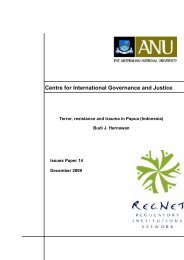
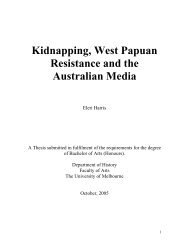
![[1958: Gahuku]. - PapuaWeb](https://img.yumpu.com/25139694/1/190x245/1958-gahuku-papuaweb.jpg?quality=85)
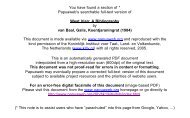


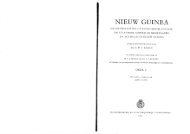
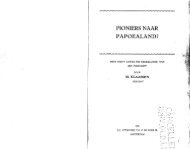
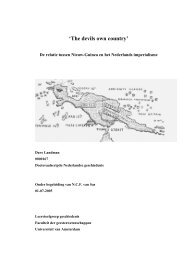
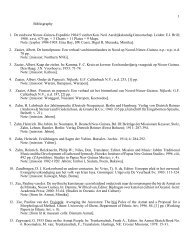
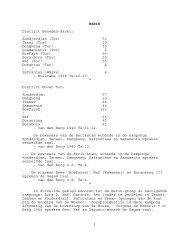

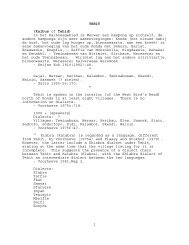
![WUTUNG [passim in text] Wutung (Oenaki, Oinåke) - Friederici ...](https://img.yumpu.com/15960045/1/190x245/wutung-passim-in-text-wutung-oenaki-oinake-friederici-.jpg?quality=85)